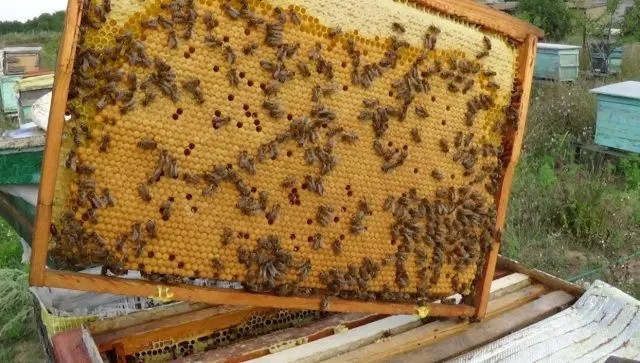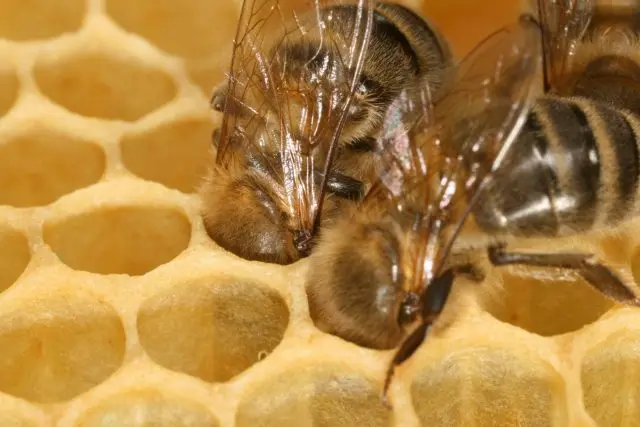Contents
Bees make honeycombs from wax. These structures perform various functions in the hive, each of which is necessary for the normal functioning of insects. In shape, they resemble hexagons, the dimensions of which depend on the size of the individuals living in them.
What are the functions of cells
In the life of a bee family, honeycombs perform a number of important functions. As a rule, they are used for the following purposes:
- honey storage;
- residence;
- breeding and maintenance of offspring.
All of these functions play a significant role in the life of insects. In beekeeping, families are provided with a building, which they further equip. In the wild, individuals do not have such an opportunity, as a result of which all the time is spent on construction, which does not allow the full production of honey.
Honey is stored in the upper cells, below the hive is much freer – there is collected pollen and flower nectar, enriched with special bee acids and enzymes.
How bees build honeycombs
Since ancient times, honeycombs made by insects have been considered the standard of architectural construction. This is due to the fact that in a small area, individuals can erect structures that are as strong, functional and efficient as possible. For construction, only wax is used, which in a softened state is able to take any geometric shape, including a hexagon – this is the shape insects give to cells. Honeycombs made by bees have certain features and purpose, therefore they differ in a number of ways.
Varieties depending on the purpose
Honeycombs erected in a beehive of wax differ in purpose. Considering the types, the following types are distinguished:
- bee – standard hexagonal honeycombs, which are later used by insects in the process of life to store honey, bee bread, and breed offspring (working individuals). There are the most cells of this type, since working individuals take the first place in number. For 1 sq. cm there are 4 cells with a depth of 10–11 mm. At the moment when the brood is open, the depth increases to 24–25 mm. When brood is grown, the space becomes much smaller as empty cocoons remain. If there is not enough space, then the walls can be completed. As a rule, the cells of the northern bees are much larger than those of the southern individuals;
- drone – in addition to honeycombs, drone cells are also erected in the hive. The difference from the previous type is the depth of 15 mm. In this case, 1 sq. see posted a maximum of 3 cells. In such combs, bees store only honey, they do not leave bee bread;
- transitional – located in those places where the transition of bees to drones is carried out. Such cells have no special purpose, they are used to fill free space. Honeycombs of this type can have any geometric shape, in most cases it is irregular. The size is average, they are not used for rearing offspring, but in some cases bees can store honey in them;
- queen cells – take up the most space in the hive and are designed for growing queen bees. Such cells are erected when the bees are preparing to swarm or if the queen has been lost. Queen cells can be swarm and fistulous. Swarms are located on the ribs of the honeycomb, eggs are laid in the first cells of the uterus, then the queen cell is built as needed.

Wax in honeycombs plays a huge role. This material is used for the construction of cells of various configurations and purposes.
Honeycomb sizes
Cells have the following dimensions:
- width – 5–6 mm;
- depth – 10-13 mm.
The cells at the top of the frame are much thicker than those at the bottom. The sizes largely depend on how large the beekeeper provided the hive and what size the individuals themselves are. As a rule, the standard size of the hive frame is 43,5 * 30 cm.
Newly built empty honeycombs are white. The cells that insects use to live in begin to darken over time. Gradually, the shade becomes light brown, after which it darkens even more. This is due to the fact that in the process of living in the cells, waste products accumulate.
Where do bees get their honeycomb wax?
Bee families not only collect honey, but also equip their hive. Bees take wax for their own honeycombs. If we examine the individual in detail, we can see that there are 4 pairs of glands on the abdomen, thanks to which the product necessary for construction is released.
The surface of these glands is smooth, thin wax strips form on it. It is worth noting that 100 such wax plates weigh about 25 mg, so for 1 kg of wax it is necessary that the bees produce 4 million such plates.
To remove wax strips from the abdomen, individuals use special tweezers located on the forelimbs. After removing them, they begin to soften the wax with their jaws. After the wax has become soft, cells are built from it. For the construction of each cell, about 130 wax plates are spent.
How bees make honeycombs from wax
In early spring, after the bees have gained enough strength after wintering, the insects begin the building process. It is during this period that special glands begin to function, responding to the production of a sufficient amount of wax.
Only wax is used for construction, this is due to the fact that this building material has a number of properties:
- plasticity. In a soft state, wax can be given any shape, which is very convenient when carrying out construction work;
- hardness. After solidification, the shape of the cells is not deformed;
- increased strength and durability;
- resistance to external factors;
- antibacterial properties allow you to protect the hive and its inhabitants from many diseases.
First of all, the bottom is erected and only after that they proceed to the construction of walls. The construction of honeycombs starts from the very top, slowly moving towards the bottom. The size of the cells depends entirely on what kind of bees live in the hive.
The performance of insects is limited, every 2 hours the bees produce wax in a certain amount. An individual with its front paws brings wax scales to the upper jaw, which, upon contact with a special substance produced by the bee, begin to be processed. Thus, the wax is crushed and softened, after which it can be used for construction.
The optimal temperature regime for the construction of honeycombs is + 35 ° С. While maintaining the set temperature, the wax is compressed and takes any shape.
New wax combs are erected over the old ones, after which the bees collect honey in them and seal them. These works are done annually by insects.

How do bees seal honeycombs
After the construction work has come to an end, the insects begin to collect honey, which is placed in cells. Throughout the season, individuals work tirelessly to fully provide themselves with food for the winter. The most crucial moment is the process of sealing the cells where honey is located.
As a rule, honeycombs are filled with honey for a quarter, the rest of the place is reserved for growing offspring. Before you start blocking the cells, it is necessary that the humidity level in the hive decreases to 20%. To do this, the bees create artificial ventilation – they begin to actively flap their wings.
Zabrus is used for sealing – a substance consisting of pollen, wax, propolis and bee bread. In addition, it contains many vitamins, micro and macro elements, essential oils.
What do wild bees make honeycombs from?
Wild individuals differ from domestic ones in that they do not live in specially prepared hives, but in nests. As a rule, in the wild, insects live in tree hollows or cracks. The main building materials are leaves, branches and grass.
In the nests of wild insects there are honeycombs that have a hexagonal shape. For construction, they use a waxy liquid that they secrete on their own. Before the onset of winter, they begin to cover all the existing holes with propolis. For wintering, they use the lower part of the nest, where there are no honeycombs and it is warmest. At the center of the family is the hive queen. Insects are constantly moving, thus they warm not only themselves, but also do not allow the uterus to freeze.
Conclusion
Bees make honeycombs in the form of regular hexagonal cells. Honeycombs are used not only for collecting and storing honey, but also for raising offspring, personal living. There are several types of honeycombs in the hives, each of which performs a specific function and bee colonies cannot do without them. The construction process in wild and domestic bees is identical. Domestic insects collect much more honey than wild counterparts due to the fact that beekeepers provide them with ready-made hives, and in natural conditions, families have to find and equip a place for wintering on their own.









